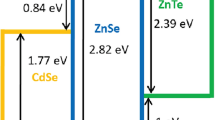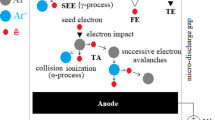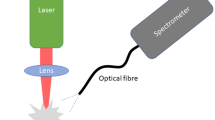Abstract
The optical and electrical properties of Ar plasma, ignited using low-frequency (LF, 60 Hz) power source, were investigated. The plasma resistance, electron temperature, and density were found to be ∼102 Ω, ∼3 eV and ∼108 cm−3, respectively. The plasma parameters are strongly dependent on Ar pressure and discharge current, and the results of optical emission analysis showed similar tendency to the probe measurements. The properties of Ar plasma are similar to DC-pulsed discharge, and the polarity of AC power can be possible of depositions and modifications on both conductive and insulating materials, unlike DC discharge. The a-C films, which are deposited using Ar-diluted CH4 plasma, showed a smooth surface, high transmittance (>80%), high sp3 concentration (∼40%) and wide optical band-gap (3.55 eV). Consequently, the LF power source was found to be a very simple, convenient and inexpensive tool to generate plasmas for various applications.
Similar content being viewed by others
References
K. K. Schuegraf, Handbook of thin film deposition processes and techniques: Principles, methods, equipment, and applications, Noyes Publication, New Jersey (1988).
M. A. Lieberman and A. J. Lichtenberg, Principles of plasma discharges and materials processing, Wiley, New York (1994).
A. Fridman, Plasma chemistry, Cambridge University Press, New York (2008).
A.W. Adamson and A. P. Gast, Physical chemistry of surfaces, Wiley, New York (1997).
H. T. Kim and S. H. Sohn, Vacuum, 86, 2146 (2012).
H. T. Kim, M. J. Kim and S. H. Sohn, J. Phys. Chem. Solids, 73, 931 (2012).
M. Shimozuma, K. Kitamore, H. Ohno, H. Hasegawa and H. Tagashira, J. Electron. Mater., 14, 573 (1985).
H.T. Kim, D.K. Park and W. S. Choi, J. Korean Phys. Soc., 42, S916 (2003).
B. Chapman, Glow discharge processes: Sputtering and plasma etching, Wiley, New York (1980).
D. N. Ruzic, Electrical probes for low temperature plasmas, AVS Press, New York (1994).
National Institute of Standards and Technology (NIST) Atomic spectra database data, http://www.nist.gov/atomic-spectroscopy.cfm.
H. R. Griem, Principle of plasma spectroscopy, Cambridge University Press, Cambridge, UK (1997).
J. Robertson, Mater. Sci. Eng., R37, 129 (2002).
J. Robertson, Surf. Coat. Technol., 50, 185 (1992).
M.W. Geis and M. A. Tamor, Encyclopedia of applied physics, VCH Publishers, New York (1993).
J. Mort and F. Jansen, Plasma deposited thin films, CRC Press, Boca Raton (1986).
Author information
Authors and Affiliations
Corresponding author
Rights and permissions
About this article
Cite this article
Kim, H.T., Kim, CD., Pyo, M.S. et al. Electrical and optical characteristics of Ar plasma generated by low-frequency (60Hz) power source. Korean J. Chem. Eng. 31, 1892–1897 (2014). https://doi.org/10.1007/s11814-014-0145-9
Received:
Accepted:
Published:
Issue Date:
DOI: https://doi.org/10.1007/s11814-014-0145-9




